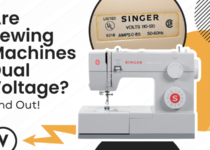Why Does My Sewing Machine Not Sew in Reverse: Answered!
Lint buildup under the stitch plate is the main cause for not sewing in reverse which can be resolved by regularly cleaning. Then, the backstitch lever of a sewing machine is broken, which can impede the machine’s reverse stitching function. And only a professional sewing machine technician can address this issue. Moreover, if the feed dogs get jammed and the sewing machine is set to automatic lock stitch, this issue may occur.
That’s not all. There are more reasons which are claimed to be responsible to initiate the issue. So, go through the whole article to learn them.
Why Does My Sewing Machine Not Sew in Reverse: Reason And Solutions
There could be multiple reasons if the sewing machine does not sew in reverse. Let’s dig them one by one along with the solutions.
Your Stitch Length Is Too Short:
If your stitch length is too short, you may not be moving the needle far enough. This can happen when your bobbin winder or needle plate is out of alignment. The needle bar should be set at more than half its average length so it doesn’t hit the fabric when sewing in reverse.
There Could Be Lint Impacted Under the Stitch Plate:
Lint or debris can gather under the stitch plate of a sewing machine. That can cause it to have difficulty sewing in reverse.
So, you must regularly clean the under-stitch plate to remove any lint buildup is essential to prevent this issue. It also helps to maintain smooth sewing operations.
Your Backstitch Lever Is Broken Or Bent:
If the backstitch lever of a sewing machine is broken, it may hinder the machine’s ability to sew in reverse. The backstitch lever is responsible for controlling the reverse stitching function, and if it is damaged or malfunctioning, the machine won’t be able to perform reverse stitches properly.

No DIY method can fix this issue. Because fixing a broken backstitch lever typically requires professional assistance from a sewing machine technician. Using their expertise, they can diagnose the problem, fix or replace the lever as needed.
Your Stitch Is Set to Automatic Lockstitch:
Selecting the automatic lockstitch setting on a sewing machine can prevent it from sewing in reverse. When this option is enabled, the machine sews a specific number of stitches and then stops sewing. Although this feature is useful for securing quilting stitches without unsightly backstitches, it restricts the reverse sewing capability.
To resolve this problem, opt for a regular stitch setting instead of the automatic lockstitch option. This allows the machine to sew in reverse as needed.
Your Feed Dogs Are Jammed:
When the feed dogs of a sewing machine get jammed, it can prevent the machine from sewing in reverse. The feed dogs are responsible for moving the fabric forward and backward during sewing. Jamming can occur due to thread, lint, or dust interfering with their movement, leading to the malfunction.
To address this issue, follow these steps:
- First, remove the fabric and turn off the machine.
- Then, take off the needle plate and clean the feed dogs using a soft brush or cloth.
- Now, use tweezers to carefully remove any thread, lint, or debris stuck in the feed dogs.
If the feed dogs are still not moving, check the stitch length. Adjusting the stitch length can help the feed dogs move properly and resolve the problem of not sewing in reverse.
You Don’t Have a Reverse Sewing Option:
If you don’t have a reverse sewing option on your machine, that can be because it does not exist. Some machines have this feature as an option, but others do not.
If your machine doesn’t have it and you want to sew in reverse, then there is an alternative! You can use a zigzag stitch instead of going through all the steps above again.
This will allow you to sew up small pieces of fabric without worrying about whether they are facing the right side or the wrong side up.
The Bobbin Winder Is Engaged:
When the bobbin winder of a sewing machine is engaged, it can prevent the machine from sewing in reverse. In this mode, the machine is set to wind the bobbin, and the needle remains still.
To get over the issue, turn off the machine and disengage the bobbin winder. After doing that check the bobbin winder mechanism to ensure it is functioning correctly. If still the issue persists, consult your machine’s manual or seek assistance from a professional technician.
The Thread Tension Needs Adjustment:
You may find that your sewing machine does not sew in reverse. If the needle is touching the fabric but doesn’t seem to be moving, try adjusting the tension on your thread by loosening or tightening the screw under where you adjust it. This can often help alleviate this issue if done correctly.
If you are using a machine with tension discs, it’s important to match those weights with what’s being sewn to equalize evenly throughout all layers of fabric.
Some machines have dials instead of discs; these are generally more accessible than disc-based models and tend not to require much adjustment unless there’s an issue between two layers’ thicknesses (such as when using multiple fabrics).
The Needle Plate May Be Damaged:
If your sewing machine is not sewing in reverse because the needle plate is damaged, it’s probably because you’ve hit it with a hammer or dropped it on the floor. The needle plate is the part that holds your needle and keeps it from falling out when you turn the handwheel.
If this component has been damaged by something as simple as a dent or crack, then your sewing machine won’t be able to sew in reverse anymore, and if you’re lucky enough to find out before purchasing another brand-new one!
The good news is that repairing these problems isn’t difficult; just take apart your machine and do some simple repairs yourself!
The Presser Foot Is Not Engaged:
If the presser foot is not engaged, it’s not in the down position. When you put your sewing machine into reverse mode and start sewing, this little lever on top of your needle will move up and down as you go through each step. The presser foot should also be down for each step to ensure that all the fabric gets pushed through with each stitch.
If your machine does not have an automatic reverse feature, it can be done manually by pressing a button or turning something over until it clicks into place (this may require some trial-and-error). If there is no manual way to engage this feature on yours, try using different types or brands of needles; they’re usually interchangeable between machines!
The Reverse Button Is Not Working Properly:
If the reverse button is not working correctly, you can try these solutions:
- Contact the manufacturer for troubleshooting help.
- Check the power supply and ensure it’s plugged in and working correctly.
- Check that there are no obstructions between your machine, the foot pedal, or any other part of your sewing machine (like a loose cable tie). You may also want to check if there is a connection between your machine and the presser foot; this could be causing issues as well!
Frequently Asked Questions (FAQs):
Can The Sewing Machine Get Locked in Reverse?
Sewing machines can occasionally become locked in reverse. However, it’s an easily solvable issue. Regular maintenance and lubrication can help prevent this problem from occurring.
What Makes A Sewing Machine Sew Backward?
In the event that the lever is jammed or functioning improperly, the sewing machine might be limited to sewing backward. Also, the sewing machine’s settings can also lead it to sew in reverse. If the machine is configured to sew in reverse mode, it will continue sewing backward until the setting is adjusted.
How Does Lock Stitch Work?
The lock stitch is a fundamental stitch found on all sewing machines. It occurs when the machine creates single stitches, with the top and bottom threads interlocking to secure the fabric. If you can sew a straight stitch using your sewing machine, you are likely already producing a lock stitch.
Conclusion
Hopefully, the answer to why does my sewing machine not sew in reverse is crystal clear now.
The situation is pretty much common to all users of sewing machines. So, don’t get panicked. Go through all the reasons along with the solution described in the article to get over this kind of situation. If the problem still persists, it’s high time to go to a professional mechanic.



